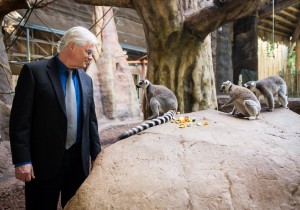Madagascar Dreaming: David Douglas, director of “Island of Lemurs.”
 By Richard Crouse – Metro Canada
By Richard Crouse – Metro Canada
David Douglas, the veteran wildlife filmmaker behind the new IMAX film Madagascar: Island of Lemurs, has dreamed of making a film on the island country in the Indian Ocean for thirty years.
He calls it a “remote and mythic place,” but adds, “in wildlife filmmaking everybody wants to go there and do it but you never can.”
But three things convinced him to take a chance and travel there “to figure out how to make the movie.”
First was the story of primatologist Dr. Patricia Wright. Douglas came across her while doing research for another film, but was taken with her efforts to protect Madagascar’s lemurs, whose numbers are shrinking to alarming levels. Around since the time of the dinosaurs, the big-eyed creatures arrived on the island as castaways from Africa and have now evolved into hundreds of species.
Douglas wanted to shine a light on Wright’s efforts to protect the lemur’s delicate ecosystem and raise awareness of their plight.
The second thing was a technological advancement.
“The normal situation in wildlife filmmaking is you have film stock, this resource that costs money and it runs through the camera in a certain amount of time,” he says. “It can’t be any longer. You have to reload it. So you have to spend a lot of your life trying to put yourself in the position of accurately predicting what an animal is going to do in the future because you want to have your camera running while its happening. That is the foundation of all of your planning and everything you do. That’s why you never see whales coming out of the water (in movies), you always see them falling back in.”
New IMAX equipment developed for this film allowed him to shoot digitally, on cameras with lots of memory. “The camera is always on and all we do is turn it off when we like what we got.”
The third draw was, of course, the lemurs themselves.
“They are spectacular looking. They look like a pile of toys in your kid’s closet because they’re all different, but they’re all sort of similar.”
The first things you notice about them are their prominent eyes. “Their eyes are radically different colors for the different species,” says Douglas. “They have every color of the rainbow of eyes.”
“Then there is the range of physical sizes. The mouse lemurs are the smallest primate on earth and up until humans got the last ones, there were really big lemurs on Madagascar; much bigger than a human being.
“Gosh, they’re fascinating animals,” he says with a hint of wonder in his voice.
